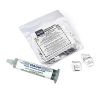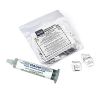Hach Digital Titrator
Features
- Eliminates cleaning and assembly chores
- Accuracy of +/-1% for most samples
- Many titrant solutions available
- Free ground shipping
- Expedited repair and warranty service
- Lifetime technical support
- More
Overview
The Hach Digital Titrator is a lightweight device that performs titrations quickly and economically at the bench or in the field. Weighing just 132 grams (less than 4 oz.), the Digital Titrator accommodates interchangeable titrant cartridges, so multiple titrations merely involve changing the cartridge and delivery tube. Snapping cartridges in and out saves the time associated with cleaning and assembling cumbersome, fragile glass burets and virtually eliminates the possibilities of cross-contamination and over-titrating.
Durable
Designed and built for durability, the Digital Titrator comes with a lifetime warranty. Hach Company will repair or replace it free of charge, provided it has not been abused. So carry it to sample sites within the water or wastewater plant; take it to the field for ecology or water quality studies - the Digital Titrator is built to withstand heavy use.
Benefits
- Faster than a burette
- Accurate to +/-1%
- Complete portability
- Interchangeable cartridges
- Multiple titration methods available
- Delivery: 800 digits/mL or 0.00125 mL/digit
- Accuracy: +/-1% for readings over 100 digits (Uncertainty of readings is 1 digit. Most samples require more than 100 digits)
- Weight: 132 g (4.7 oz.)
- (1) Digital titrator, 0.00125 mL/digit
- (5) Straight delivery tubes
- (1) Carrying case
- (1) Operations manual
In The News
Monitoring Mariculture in the Gulf of Alaska
The mariculture industry in the Gulf of Alaska has been steadily growing in recent years, guided by ongoing research to help refine farm location and cultivation practices. A subset of aquaculture, mariculture focuses on rearing organisms in the open ocean. In Alaska, finfish farming is illegal, so most farms cultivate kelp, oysters, or a combination of the two. These small, locally operated farms started popping up in the Gulf of Alaska in the early 1990s, when shellfish farming first became legal. Kelp farming did not begin to catch on in the state until 2016. Many of the coastal areas that have grown interested in mariculture are historically commercial fishing communities.
Read MoreSupplying Seattle’s Drinking Water: Using Data Buoys to Monitor the Cedar River Municipal Watershed
Providing clean, safe, and reliable drinking water for the 1.6 million people in the greater Seattle area is a top priority for Seattle Public Utilities (SPU). With limited water supplies, SPU dedicates considerable resources to maintain its watersheds and mountain reservoirs. About 70 percent of Seattle Water comes from the Cedar River Municipal Watershed , and the other 30 percent comes from the South Fork Tolt River Watershed . [caption id="attachment_39574" align="alignnone" width="940"] Data buoy in Chester Morse Lake . (Credit: Kevin Johnson / Seattle Public Utilities) [/caption] Jamie Thompson, a fisheries biologist at SPU, monitors aquatic ecosystems centered on fish listed under the U.S. Endangered Species Act (ESA).
Read MoreData-Driven Advocacy on the Lower Deschutes River
Like many freshwater environments, the Deschutes River in Oregon is under pressure from development, pollution, and climate change. Many rivers, streams and lakes in the Deschutes Basin do not meet Oregon water quality standards –where state water quality monitoring assesses levels of bacteria, pH, dissolved oxygen, temperature, and fine sediment. Hannah Camel is the Water Quality Coordinator for the Deschutes River Alliance (DRA), a non-profit organization that focuses on the health of the lower 100 miles of the Deschutes River–the area most affected by human intervention. As a data-driven organization, the DRA has benefited from the installation of two NexSens X2 data loggers.
Read More

































































